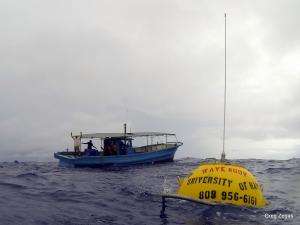PacIOOS wave buoy in Majuro helps keep islanders safe

If the ocean swell is too high, the safety of fishermen transiting out of the lagoon to open waters is threatened, homes and businesses may be flooded with seawater, roadways may become impassable, and even the runway strip at the airport may be rendered useless for large commercial aircraft. This is the reality of islanders living on Majuro Atoll in the Republic of the Marshall Islands (RMI), and this is why providing near real-time ocean information to this part of the Pacific is a priority of the Pacific Islands Ocean Observing System (PacIOOS).
On July 10, 2014, PacIOOS collaborated with partners to deploy a new Datawell Directional Waverider buoy named "Kalo" about 1 mile off the eastern shore of Majuro. The buoy measures wave height, wave direction, wave period, and sea surface temperature every 30 minutes. The PacIOOS wave buoy streams data to inform safe transit and recreation and provide critical information for the National Weather Service to produce accurate high surf forecasts and advisories and surf zone forecasts.
Genevieve Miller, the Meteorologist-in-Charge of the National Weather Service Forecast Office in Guam (WFO Guam), stated, "Wave forecasting for the Marshall Islands is one of our most challenging tasks. The PacIOOS wave buoy has been an invaluable tool in supporting our goals to better understand and predict damaging waves affecting Majuro." The Warning Coordination Meteorologist at WFO Guam, Chip Guard, added, "PacIOOS has been a tremendous ally for us ocean wave forecasters west of the International Date Line. The Majuro wave buoy has revealed many of the unique characteristics of the potentially destructive waves that threaten the atoll from the east, south and west. It will reveal more secrets, and we will eventually solve the wave forecasting challenge at Majuro."
The direction of incoming swell is believed to be a critical feature affecting how much societal impact a particular event may have on Majuro. The PacIOOS wave buoy provides the critical swell spectra for ocean users, weather forecasters, and researchers developing inundation forecasts for the atoll. PacIOOS hopes to use the data from the wave buoy to eventually develop a wave run-up forecast for the region, and this buoy will be a vital validation and accuracy tool for this effort.
PacIOOS requests boaters to steer clear of the buoy by 50 feet and not to tie off onto the buoy. The intricate mechanisms located inside render this buoy susceptible to damages. Recovery and redeployment of this buoy is expensive and challenging, as the team relies on calm ocean conditions to safely deploy these sensitive instruments that weigh 500 pounds.
The buoy is part of PacIOOS' network of twelve near-real-time wave buoys in Hawai'i, Guam, the Northern Mariana Islands, and the Marshall Islands. Data stream from the buoys to the PacIOOS Voyager (pacioos.org/voyager), the PacIOOS website (pacioos.org), and to the Coastal Data Information Program (CDIP) at Scripps Institution of Oceanography. Data streaming is made possible through long-term partnerships between PacIOOS, the U.S. Army Corps of Engineers, and CDIP.
More information: To view the data from the "Kalo" wave buoy, go to pacioos.org/wavebuoy/kalobuoy.php.
On the go? Click on pacioos.org/voyager/mobile/ind … n=rmi&variable=waves to go to the PacIOOS Voyager Mobile tool and click on the wave buoy for near real-time wave conditions.
Provided by University of Hawaii at Manoa

















